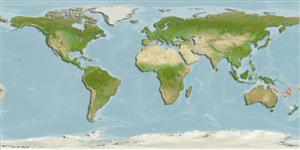klasifikasi / Names
Nama-nama umum | Sinonim (persamaan) | Catalog of Fishes(Marga, Jenis) | ITIS | CoL | WoRMS | Cloffa
>
Pleuronectiformes (Flatfishes) >
Poecilopsettidae (Bigeye flounders)
Etymology: Poecilopsetta: Greek, poikilos = with a lot of colours + Greek, psetta = grouper (Ref. 45335); pectoralis: Named for its long pectoral fin on the ocular side..
Environment: milieu / climate zone / depth range / distribution range
Ekologi
laut batidemersal; kisaran kedalaman 510 - 580 m (Ref. 58291). Deep-water
Western Pacific: New Caledonia.
Size / Weight / umur
Maturity: Lm ? range ? - ? cm
Max length : 14.7 cm SL jantan/; (Ref. 58291); 15.9 cm SL (female)
deskripsi pendek
Morfologi | Morfometrik
duri punggung lunak (Keseluruhan (total)): 63-65; Sirip dubur lunak: 52 - 55. This species is characterized by the following: lateral line scales 99-105; deep body, 2.11-2.34 in SL; narrow interorbital width 37-50.71 in HL); long ocular-side pectoral fin, 0.89-1.2 in HL; no scales on snout from tip to anterior interorbital region; 8 obscure dusky transverse bands of body on ocular side; 4 dark spots in submarginal area of the caudal fin (Ref. 58291).
Life cycle and mating behavior
Kematangan | Reproduksi, perkembang biakan | Pemijahan | telur-telur | Fecundity | Larva
Kawai, T. and K. Amaoka, 2006. A new righteye flounder, Poecilopsetta pectoralis (Pleuronectiformes: Poecilopsettidae), from New Caledonia. Ichthyol. Res. 53:264-268. (Ref. 58291)
Status IUCN Red List (Ref. 130435)
ancaman kepada manusia
Harmless
penggunaan manusia
informasi lanjut
Nama-nama umumSinonim (persamaan)metabolismePemangsaEkotoksikologiReproduksi, perkembang biakanKematanganPemijahanSpawning aggregationFecunditytelur-telurpekembangan telor
Umur / SaizPertumbuhanpanjang-beratpanjang-panjangukuran frekuensiMorfometrikMorfologiLarvaDinamika larvapemulihanKelimpahanBRUVS
AcuanBudidaya airprofil budidaya airStrainGenetikaElectrophoresesDiturunkanPenyakit-penyakitPengolahanNutrientsMass conversion
mitraGambarStamps, Coins Misc.Suara-suaraCiguateraKecepatanTipe renangArea insangOtolithsOtakPenglihatan / visi
Alat, peralatan
laporan khas
muat turun XML
Sumber internet
Estimates based on models
Preferred temperature (Ref.
123201): 6.8 - 9.6, mean 7.6 °C (based on 24 cells).
Phylogenetic diversity index (Ref.
82804): PD
50 = 0.5000 [Uniqueness, from 0.5 = low to 2.0 = high].
Bayesian length-weight: a=0.01995 (0.00906 - 0.04395), b=3.01 (2.83 - 3.19), in cm total length, based on all LWR estimates for this body shape (Ref.
93245).
Trophic level (Ref.
69278): 3.5 ±0.4 se; based on size and trophs of closest relatives
Fishing Vulnerability (Ref.
59153): Low vulnerability (10 of 100).
